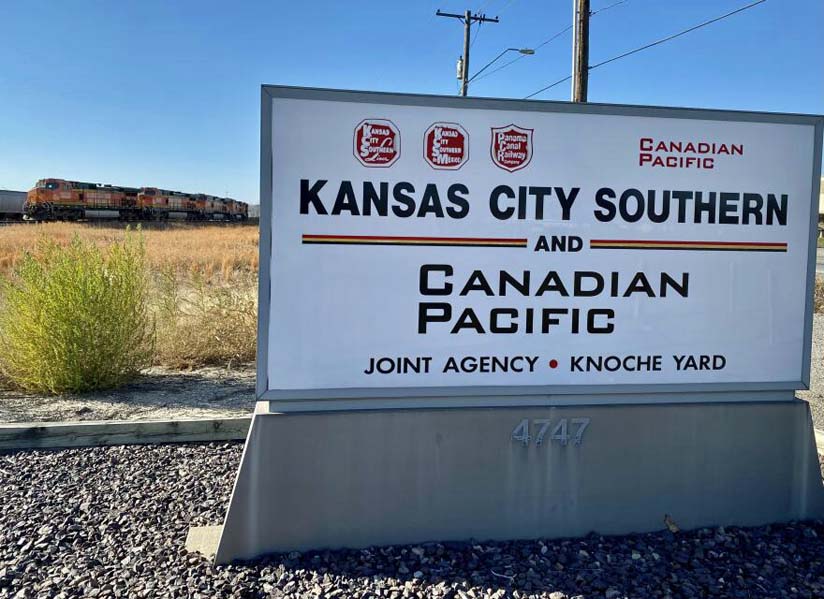
America
Kansas City Missouri USA - While Kansas City Southern (KCS) will no longer exist as a stand-alone company, the headquarters of the merged
company will remain in downtown Kansas City, where KC Southern has been based for decades.
KCS shareholders on Friday overwhelmingly approved a US$31 billion merger with Canadian Pacific (CP), meaning the Kansas City-based railroad will cease to
exist as a stand-alone company.
But the merger will make history, boost efficiency, and could swell the ranks of railroad management in Kansas City, even as it re-shapes the railroad industry
in a way that could have real staying power.
KCS has 6,700 miles of track in the U.S. and Mexico.
CP has well over twice that mileage, stretching coast to coast across Canada and into the U.S.
The railroads meet in just one place, the KCS Joint Agency Yard in Kansas City's East Bottoms.
CP goes north from Kansas City, while KCS goes south to Gulf ports in Mississippi, Louisiana, Texas, and both coasts of Mexico.
It's an elegant match.
"From a regulatory standpoint. It's not a heavy lift. It's an end-to-end merger. There's no overlap whatsoever," says Railway Age editor-in-chief
Bill Vantuono.
First Transnational Railroad
Vantuono says that seamlessly connecting the wheat fields and oil fields of central Canada with ports on the Gulf of Mexico, and connecting Mexican car and
appliance factories with customers through the middle of the U.S. and across Canada, will cut shipping time significantly.
And he says this would be something new in the nearly 200 year history of North American railroading.
"This is the first transnational railway," he proclaims.
KCS is by far the smallest of the seven major North American railroads, but Vantuono says this is not a case of a failing company being acquired by a
successful one.
"It's a strong railroad. It always has been, it has a great history. I'm surprised it's remained independent this long," Vantuono says of
KCS.
KCS has managed to stay independent, in part, because big railroad mergers are rare these days.
There hasn't been one in more than 20 years.
Regulators are leery of such mergers because the number of railroads plummeted last century.
There are seven Class 1 railroads now, once upon a time there were hundreds.
Railroads were among the original monopolies.
Railroad barons made fortunes gouging shipping customers who had no other options.
So maintaining competition among railroads is central to regulatory policy.
And for decades regulators worried that one more merger could trigger a round of consolidation, ending with two or three colossal railroads.
It's a fear that's hung over the industry like an end-times prophecy.
Vantuono says the one merger possible that would not lead to that outcome is the one between the two smallest Class 1 railroads, namely CP and
KCS.
"This is not going to touch off the final round of mergers," Vantuono assures.
In fact, proponents of the merger say that marrying KCS and CP sets up a stable, even symmetrical, railroad map.
"You have two railroads in the west, you have two railroads in the east, and you have two railroads that go across Canada and also run north, south, and
the center of the U.S." says CP spokesman Patrick Waldron of the industry map altered by the proposed merger.
A win for Kansas City?
While KCS will no longer exist as a stand-alone company, the headquarters of the merged company will remain in downtown Kansas City, where KCS has been based
for decades.
Waldron says employment here would be stable, or even grow, as jobs from CP's current U.S. headquarters in Minneapolis migrate to Kansas City.
The company also anticipates hauling a lot more freight after the merger.
They're going to need more people. This is a growth scenario here," Vantuono says.
The combined company projects spending more than US$250 million dollars on track improvements, and Vantuono says the merger could also bring something fun to
Kansas City.
"Amtrak sees opportunity for a new service, from Kansas city to New Orleans," he says.
KCS has long maintained track to New Orleans and had a passenger service there called the Dixie Belle through the 1940s, 1950s and 1960s.
Vantuono says Amtrak may revisit that route as it expands because it has a good working relationship with CP.
And then there's the name.
Kansas City will retain its status, along with Santa Fe, as a named railroad town.
The new railroad will be called Canadian Pacific Kansas City Limited.
Frank Morris.
(there was no image with original article)
(usually because it's been seen before)
provisions in Section 29 of the Canadian
Copyright Modernization Act.
